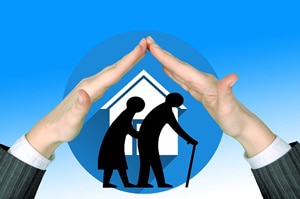
May 18, 2020
A Look At Nursing Homes
By Michael D. Shaw
Nursing homes have been in the news since the beginning of the COVID-19 pandemic. Among the earliest cases publicized in the US involved a serious outbreak in a long-term care skilled nursing facility in King County, Washington. This was the Life Care Center in Kirkland, WA.
Sadly, nursing homes have become hotbeds of SARS-CoV-2 infection. And there are vast disparities between states. Consider that Gov. DeSantis of Florida has strictly regulated incoming patients, while Gov. Cuomo of New York issued a directive prohibiting nursing homes from testing recovering coronavirus patients prior to admission. The results: Florida has about one-seventh of the COVID-19 deaths in nursing homes.
Let’s start out with some basics. What exactly is a “nursing home”? According to medicare.gov, “Nursing home is a term that includes both skilled nursing facilities and nursing facilities. Nursing homes primarily engage in providing residents skilled nursing care and related services for residents who require medical or nursing care and rehabilitation services for the rehabilitation of injured, disabled, or sick individuals.” The types of nursing homes are further defined here.
The infamous Kirkland, WA outbreak occurred in a long-term care skilled nursing facility. These days, most SNFs are also rehabilitative facilities and long-term care facilities. A skilled facility offers 24-hour care by licensed professionals, such as RNs, LPNs, occupational, physical, and speech therapists. There is at least one physician that also oversees the care of each patient.
Nursing home care is similar in that certified nurses are present. Meal preparation and non-medical assistance in such activities as bathing are provided. However, these facilities lack the robust presence of on-site licensed medical practitioners, compared to an SNF. Nursing home care offers permanent custodial assistance, while a skilled nursing facility is more often temporary, to solve a specific medical need or to allow recovery outside a hospital.
Bear in mind that these distinctions are not hard and fast. If you or a loved one are considering some form of nursing home care, Medicare/Medicaid coverage should be examined, as well as the rating of the facility.
For a quick historical perspective, nursing homes derive from almshouses, dating back to medieval times when religious orders cared for the poor and the indigent sick. The spirit of almshouses lives on in such organizations as the Little Sisters of the Poor, founded by St. Jeanne Jugan.
How do we explain the “staggering” number of COVID-19 deaths that are occurring in nursing homes? We can argue about the way the CDC determines who actually died of COVID-19, but the fact is that for most states, at least a third of COVID-19 deaths are in long-term care facilities.
So, why have these facilities been hit so hard? New York Times writer Jane Margolies offers a few reasons:
- A lack of safety gear (aka personal protective equipment) and not enough staff on hand
- COVID-19 is naturally going to hit older people, already saddled with numerous health conditions, and the outcomes are worse in this age/health cohort.
- Building designs are set up for maximum efficiency, encouraging too high a population of residents.
As to the notion of too many residents, Richard J. Mollot, executive director of the Long Term Care Community Coalition, an advocacy group for residents, weighs in: “[W]hy are we seeing such a high rate in nursing homes? Rather than a long hallway with 40 rooms and 80 or more residents, you have these spots [nursing homes] with more like 16 residents.”
Mollot’s NY Times opinion piece, entitled “Nursing Homes Were a Disaster Waiting to Happen” spells it out clearly…
“It was clear almost from the outset that the elderly and frail were in the greatest danger from COVID-19. And it was clear to anyone familiar with American nursing homes that they would not be up to the task of protecting their older and infirm residents. One-third of Medicare beneficiaries admitted to homes suffer harm within about two weeks of entry…These are the short-term residents for whom homes are paid the most and who are typically most able to articulate their concerns if something is wrong. Where does that leave a majority of residents who are there long-term, most of whom are older, frail and cognitively impaired?”
“A pandemic is a force of nature that cannot be avoided. But years of neglect by nursing homes have left millions of older residents unprotected from it. Many of the deaths we’ve seen could have been prevented. More lives can be saved if we demand more from the industry and from its regulators.”
Maybe it would also help to invoke the spirit of St. Jeanne Jugan.
